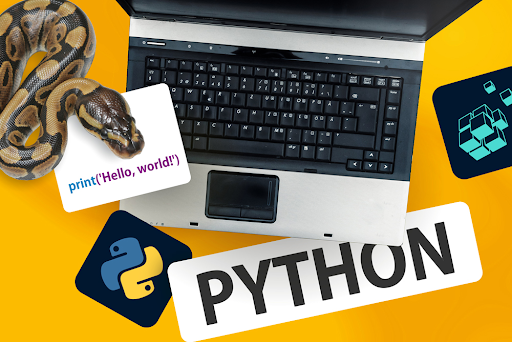What is Python and Why Is It Important?

The programming language Python was first introduced in 1991 as a general-purpose code set. If you are new to the inner workings of technology, you may not know how pervasive Python is in the tech world around you. Do you watch Netflix? Python drives the algorithm for recommending your next programs based on what you have already viewed. Have you taken a ride in a self-driving car? Python is the brains in the vehicle. Do you use Pinterest, Spotify, or Instagram? Guess what programming language was used to create these social media staples—Python.
If you are considering a career change to the Information Technology industry, Python is an excellent path to an exciting, challenging, and rewarding career. Python was rated the most popular language among programmers in 2020 according to analysis firm RedMonk. Read more about the innovative things you can do in a remote tech job using Python, and then learn how quickly you can train to prepare yourself for your first Python programming job.
What is Python used for?
The most common applications of Python include websites, automation, data visualization, and machine learning.
Website Development
In website development, programmers use Python most often to create the back-end services, that is, the logic and processes behind the website’s front-end pages. Python modules send data back and forth between the database and the application’s webpages. Python code validates the data entered by the users and transforms it for storage. It also managing the security of the application to ensure that only authorized users access and update data.
Automation
Python’s role in automation is to turn repetitive, manually intensive digital tasks into push-button operations. Python can be used to script predictable, mundane tasks, such as sending reminder emails to customers, finding and correcting errors in files, removing duplicate records, and performing simple mathematical calculations.
Data Visualization
Python’s ability to automate has become a crucial element in the field of data science. Data science involves performing complex statistical calculations on large volumes of data. Data analysts often choose Python to create intelligent algorithms to distill mountains of data into meaningful nuggets of information. The analysts then use Python’s powerful visualization features to create pie charts, bar and line graphs, histograms, and 3D plots to make the statistical information easy to understand.
Machine Learning
An exciting application of Python is in the development of machine learning. Python is a syntactically simple language, yet it has the power to handle highly complex operations. Included in the Python language is an extensive set of libraries containing tested and proven modules to perform machine learning and artificial intelligent processes. With Python, the programmers do not have to reinvent how machine learning works, they simply apply the appropriate libraries to solve the end objectives of their machine learning project.
Why is Python so powerful?
One powerful element of Python is its simplicity. It is easy to write and easy to read. Its syntax and vocabulary were designed to be English-like.
Because it is a general-purpose language, you can write virtually any kind of program with it. Some languages are specifically designed to perform certain tasks, such are rendering graphics, producing reports, or performing mathematical calculations. If you want to do something with these specialized languages other than what they were designed for, it can be very difficult or even impossible. Python, on the other hand, is in a class with Java, C, and C++. If a computer’s circuits can do something, Python can make them do it.
Particularly useful to programmers are the wide array of libraries included with Python. Experts have solved many problems and built many modules that have been compiled into libraries. A Python program can incorporate these libraries to turn a difficult problem into a simple solution. Programmers also love the fact that Python can interface with subroutines written in other languages, such as C and C++. If a routine has already been developed in one of these other languages, the Python program can use it without changing it.
Who uses Python?
Given Python’s popularity in the software development community, you should not be surprised to learn that Python is used by such industry-leaders as Uber, Goldman Sachs, Intel, and Paypal. Google has been a proponent of Python since the earliest days. This simple programming language provides for ease of maintenance and fast delivery of software. Facebook also relies on Python to make the job of the software engineers easier so they can deliver improvements and new features faster. Much of the code behind the popular Dropbox file sharing system is Python.
Is Python easy to learn?
This question has two answers. To get a basic grasp of the language so you can start to create simple programs to solve everyday problems takes the average person a couple of weeks. To become a Python master, however, requires several months of concentrated study and practice. How masterful you need to become in the language depends on the job you are seeking.
Because Python is easy to read and structurally logical, beginners do not find it daunting. The format of a Python program is visually uncluttered. Python relies on English keywords rather than arcane punctuation. Indentation is used to identify blocks of code, which is a common attribute of English writing. Statements and flow-control structures are readily understandable English words and symbols. Mathematical expressions operate as you would expect from Algebra class.
These and other features were designed by the creator of Python to make it an easy language to learn. Yet, the power of the libraries and the language’s ability to interact with modules written in other languages make Python an endlessly useful and effective language for solving highly complex problems.
Final Thoughts
Python is an excellent starting point for a career in software development. With Python you can learn the processes of coding without getting tangled up in the intricacies of problematic punctuation and esoteric vocabulary. If you can say it in English, you can program it in Python. It is a popular entry-level language for new programmers as well as a high-demand skill for many employers.
When you enroll in the Python career track at RemoteMode, you can train for your first programming job in as little as six months studying remotely from your home for an hour a day. RemoteMode’s full-service program not only provides you with professionally developed courses, but it also gives you access to personal mentors, industry experts, immersive learning with hands-on projects, and job preparation skills, such as social media networking, resume writing, and interview rehearsals. RemoteMode does more than teach you to code, it helps you get that all-important first job that will launch your new remote tech career. Visit RemoteMode’s website or contact a RemoteMode career advisor today to learn how quickly you can be ready to pivot to a new career and a new life.
Take the first step to your new remote career!






